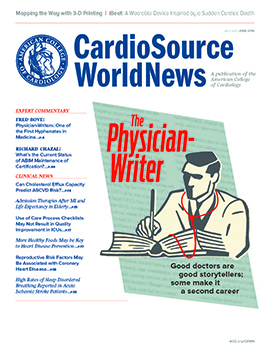Straight Talk: Pediatric Cardiac Care and the Global Health Agenda | Gerard Martin, MD
CardioSource WorldNews | My work in population health has made me increasingly aware of global health challenges—especially our approaches to meeting those challenges. To meet the health needs of adults and children with cardiovascular disease worldwide there is an enormous need for sustainable solutions that build local capacity.
As members of a professional society of cardiologists, many of us in the ACC are concerned with global access to care. One of the more daunting challenges we face is the need for sustainable, high-quality care for children with congenital heart defects (CHDs). The incidence of CHDs around the world is constant, with one in 120 newborns—or one million children worldwide each year—born with a CHD. Yet 90% of these children lack access to the care they need.
Many well-intentioned efforts to meet the needs of these pediatric patients fall short. When only 7% of the population in developing countries has access to surgery for pediatric cardiovascular disease, we need to focus on building local capacity in order to treat large numbers of children.
Children’s HeartLink is an organization that works to improve access to high-quality care through training and empowerment, and the development of pediatric cardiac Centers of Excellence in underserved regions. To draw attention to this important and urgent issue, the international development organization based in Minneapolis recently released the third issue brief in a series of four: Treating The Invisible Child: Childhood Heart Disease and the Global Health Agenda.
Congenital abnormalities will be the fifth leading cause of death of young children by 2030, with cardiovascular disease responsible for the majority within this set. The Sustainable Development Goals’ call for the end of preventable child deaths by 2030 will not be achieved if investment to build local capacity and health system resiliency to address the needs of children with cardiovascular disease is not recognized by the global health community.
How do we ensure that the needs of these children are met? The success and sustainability of pediatric cardiac care in developing countries is dependent on the following:
1. Increasing capacity to care for children with cardiovascular disease.
- Eighty-five percent of children with CHD can survive into adulthood when pediatric cardiac care is incorporated into a health system’s full continuum of care.
- Children’s HeartLink is leading the effort to develop sustainable Centers of Excellence in pediatric cardiac care in developing countries. Last year alone over 84,000 children were served by local specialists at 13 Children’s HeartLink’s partner hospitals in six countries.
2. Building a pediatric cardiac workforce.
- Only 20% of the world’s specialist surgeons attend to the poorest half of the world’s population. Very few of these surgeons have received training in how to diagnose, manage and treat children with cardiovascular disease.
- Investing in regional training centers that can adapt best practices to local settings is key to building a pediatric cardiac workforce.
- When pediatric cardiac care involves integrated case management, the entire health system benefits from scaling up care for children with cardiovascular disease.
3. Closing the data gap.
- Little data exists on pediatric cardiovascular disease in developing countries because health workers are not secure in their ability to detect cardiovascular disease in children, predominant surveillance methods are not robust enough to assign cardiovascular disease as cause of death, and there are few national and international registries of pediatric cardiovascular disease.
4. Financing pediatric cardiac care.
- By 2030, more than 40 current low- and middle-income countries will have the health system capacity to incorporate care for children with cardiovascular disease. Domestic investments matched by local commitment to including pediatric cardiac care in development aid for health is needed to make this a reality. Without this commitment, treatment will be catastrophically impoverishing to most families in developing countries.
In May 2015 the World Health Assembly adopted a resolution on surgical care and anesthesia as a component of universal health coverage. Surgery for birth defects was included in this resolution. (For more on this topic, see the article, “World Health Assembly: A Time For Renewed Commitment to Reducing NCDs.”)
Children with cardiovascular disease in underserved regions need our help. I urge you to join me and many of our fellow ACC members by becoming involved in this timely and important cause.
Gerard Martin, MD, FACC, is medical director of Global Services of Children’s National Health System, chair of ACC’s Population Health Policy and Health Promotion Committee, and a past-chair of ACC’s ACPC Section.

|
Read the full July issue of CardioSource WorldNews at ACC.org/CSWN |
Keywords: CardioSource WorldNews, Developing Countries, Child, Global Health, Heart Defects, Congenital, Infant, Newborn, Pediatrics
< Back to Listings
